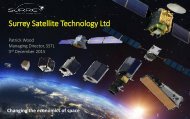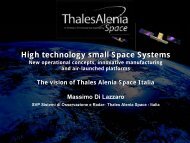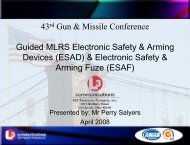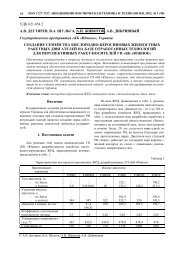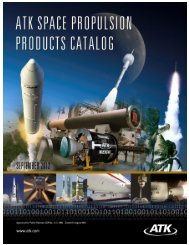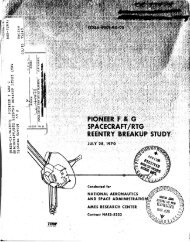Create successful ePaper yourself
Turn your PDF publications into a flip-book with our unique Google optimized e-Paper software.
<strong>UNISEC</strong> <strong>Global</strong> <strong>Meeting</strong><br />
<strong>Tokyo</strong>, <strong>July</strong> <strong>2015</strong><br />
(Pre-workshop for the 4 th Mission Idea Contest for<br />
Micro / Nano Satellite Utilisation)
SSTL Overview<br />
• UK small satellite mission provider<br />
• - owned by 99% Airbus Defence & Space 1%<br />
University of Surrey<br />
• Incorporated in 1985, employs 500 staff<br />
across facilities in the UK (Surrey, Kent,<br />
Hampshire) & US (Colorado)
SSTL – The Stats<br />
34 +<br />
43<br />
21<br />
Years+ in operation.<br />
6 Oct 1981 to date.<br />
SSTL<br />
satellites<br />
launched<br />
Satellites in manufacture<br />
22<br />
Payloads in manufacture<br />
5<br />
Number of SSTL constellations<br />
deployed and under contract<br />
(DMC, RapidEye, F7, DMC3,<br />
Kanopus)<br />
Changing the Economics of Space<br />
As at <strong>July</strong> 2014
SSTL’s fleet of small satellites<br />
SSTL-X50<br />
Cubesats<br />
SSTL NovaSAR<br />
SSTL 100<br />
SSTL 150<br />
SSTL 300<br />
SSTL 300 S1<br />
SSTL GMP-T
Japanese Collaborators
SSTJ – Resource Provider into MIC<br />
Leverage SSTL’s expertise to assist MIC<br />
participants through:<br />
1. Mentoring – providing technical advice<br />
2. Work-shop participation<br />
3. Training & Development<br />
4. Provision of heritage platforms and subsystems
SSTL Available Resources<br />
Full mission capability from definition through to launch, commission, operations<br />
& exploitation<br />
Mission Definition and Design<br />
Sub Systems Design and Manufacturing<br />
Assembly & Integration<br />
Testing<br />
Environmental Testing<br />
Launch<br />
Mission Commission & Operations<br />
Image Processing & Application
SSTL collaborations with Japan Space<br />
Industry include:<br />
1. Mission Concept Studies<br />
2. Microsatellite Mission Training<br />
3. Space Market Study & Analysis<br />
4. Technical (spacecraft, platform & equipment)<br />
Studies<br />
5. Subsystem provision (EM & FM)<br />
5. Ground Station Provision / Training<br />
6. Down stream data service provision
Japanese Missions Supported by SSTL<br />
SLATS<br />
ChubuSat<br />
JAXA / MELCO SLATS –<br />
SSTL provided Study<br />
support and is<br />
supplying GPS space<br />
receiver<br />
ChubuSat – MHI /<br />
Nagoya Uni. SSTL’s<br />
10SP-M reaction<br />
wheel based-lined<br />
on Chubusat series<br />
SOCRATES<br />
NICT SOCRATES – AES<br />
prime. SSTL supplied<br />
reaction wheels<br />
SDS-4<br />
JAXA Tsukuba SDS-4<br />
SSTL supplied 10SP-M<br />
reaction wheels<br />
Tohoku Uni. Rising-2. SSTL<br />
supplied GPS receiver
SSTL Micro / Nano Platforms Provision<br />
- enabling MIC participants to focus on<br />
the mission concept
SSTL Satellite Platforms<br />
• A wide range of platforms for small satellites<br />
• Many heritage missions and structure configurations<br />
• All based on SSTL standard avionics *<br />
– Standard power and data interfaces<br />
• Highly flexible and configurable, using heritage<br />
equipment and system configurations<br />
– S-band TM/TC, 28V power bus, CAN OBDH<br />
– Heritage structure configurations or new structure<br />
– Single string / dual or multiple redundancy avionics<br />
– Scalable power systems with body mounted or deployed panels<br />
– A range of AOCS sensors and actuators<br />
– Various propulsion system solutions<br />
– Various payload support solutions, including high speed data recorders and downlink<br />
* SSTL is now introducing new “Fireworks” avionics on the SSTL-X series, which eventually will<br />
be rolled out across other platforms. KazSTSAT will fly this avionics set in 2016. Cubesats and<br />
GEO Commsats are special cases using largely custom avionics
Platform Heritage<br />
STRaND-1<br />
SSTL C-1<br />
KazSTSAT<br />
PicoSAT<br />
AlSAT-1<br />
NigeriaSat-1<br />
UK-DMC-1<br />
UK-DMC-2<br />
Deimos-1<br />
NigeriaSat-X<br />
exactEarth-1<br />
AlSAT-1b<br />
TOPSAT<br />
Beijing-1<br />
RapidEye (x5)<br />
Sapphire<br />
TechDemoSat-1<br />
Nano-X<br />
SSTL-FLY<br />
X-50<br />
SSTL-100<br />
SSTL-150<br />
SSTL-150E<br />
ESPA variant<br />
Low complexity platform<br />
• Typically
Nano / Microsatellite Platforms<br />
Platform Cube-X Nano-X SSTL-X50 SSTL-100 SSTL-150<br />
Payload<br />
Mass (kg)
Low complexity platforms<br />
• CubeSAT<br />
• Nano-X<br />
• SSTL-X50
SSTL “Cube-X” Cubesats<br />
• Heritage: SNAP-1; STRaND (2013).<br />
• For professional missions where a Cubesat is the<br />
appropriate nanosatellite solution<br />
– E.g. contractual requirements to meet certain mission objectives<br />
– Leverages SSTL mission engineering capabilities<br />
– Typically 3U, 6U, 12U, 15U, 24U or 27U form factor<br />
– Wide range of launch opportunities<br />
– Using third-party avionics where appropriate<br />
• Leverages University of Surrey Surrey Space Centre<br />
science and technology cubesat mission programme<br />
– CubeSail – de-orbit<br />
– AARest – autonomous assembly & reconfiguration<br />
– QB50 – EU thermosphere science mission
SSTL Nano-X<br />
• Scalable Nano/Microsat platform<br />
• Targeted at very low cost, fast delivery missions<br />
• Based on SSTL “Fireworks” avionics<br />
• Partial redundancy in key systems<br />
Typical platform characteristics<br />
Typical block diagram<br />
Mission mass<br />
Payload mass<br />
Payload power<br />
Data interface<br />
Pointing Control<br />
Downlink rate<br />
Design lifetime<br />
Up to 40kg<br />
Up to 20kg<br />
29W (without deployable panels)<br />
Up to 1 Gbps<br />
0.1deg<br />
Up to 50Mbps<br />
1 to 2 years<br />
Payload
SSTL X-50<br />
The X50 offers a highly flexible microsatellite platform,<br />
featuring an innovative modular avionics suite, that can be<br />
scaled up or down to match the needs of a wide variety of<br />
payloads. High speed data storage and processing makes it<br />
extremely capable for high data volume applications, such as<br />
video from space and high resolution imagery.<br />
Platform Services<br />
Payload Accommodation & Services<br />
Payload<br />
Mass<br />
Payload<br />
Volume<br />
Payload<br />
Orbit<br />
Average<br />
Power<br />
Payload Peak<br />
Power<br />
Payload FoV<br />
Scalable, typically up to 45kg<br />
Scalable, typically starting<br />
from:<br />
0.5 m x 0.4 m x 0.3 m<br />
Scalable, typically up to 35 W<br />
(can be increased with<br />
additional arrays)<br />
Scalable, typically up to 85 W<br />
(can be increased with<br />
additional arrays)<br />
Unobstructed FoV possible<br />
System<br />
robustness<br />
Data Bus<br />
High Speed<br />
Data<br />
Interfaces<br />
On-Board Data<br />
Storage<br />
Power Bus<br />
Comms<br />
System<br />
Interfaces<br />
Redundant Design – no single point<br />
of failure<br />
CAN bus standard<br />
Also featuring: RS485, LVDS, UART<br />
GigaBit per second payload data<br />
bus direct to data storage or<br />
downlink.<br />
Standard 2 TB<br />
Optional upgrade to 4 TB<br />
28V Unregulated<br />
S-band Uplink<br />
S-Band<br />
Downlink<br />
X-band<br />
Downlink<br />
Up to 600 kbps<br />
Up to 2.2 Mbps<br />
Up to 1Gbps
• Targeted at low cost, fast delivery missions<br />
• Production engineered for automated manufacture and test<br />
– Fast delivery (12-24 months)<br />
– Cost efficient for constellations<br />
• Dual redundant avionics<br />
– Scalable power and OBDH<br />
– Gbps payload interfaces, Tbyte storage, 3-axis control<br />
• First flight KazSTSAT in 2016<br />
SSTL X-50<br />
Supported Orbit<br />
Types<br />
Sun synchronous (standard)<br />
Low altitudes supported<br />
Non sun sync (optional upgrade)<br />
Attitude Modes<br />
Earth Referenced (standard)<br />
Inertial Reference Platforms Available<br />
Design Lifetime<br />
Satellite Mass<br />
Satellite<br />
Dimensions<br />
Compatible<br />
Launchers<br />
5-7 years<br />
Total mass typically in the range<br />
50 – 200 kg<br />
Typically less than 1 m 3<br />
Dnepr, Falcon-1, H-IIA, Soyouz, Delta-IV
SSTL-150<br />
• Dual redundant avionics<br />
– Scalable power and OBDH<br />
– 3-axis control, Agile<br />
• Extensive heritage<br />
– 9 spacecraft<br />
– Listed in the NASA ID/IQ catalogue<br />
Typical platform characteristics<br />
Mission mass<br />
Payload mass<br />
Payload power<br />
Pointing Control<br />
Downlink rate<br />
Design lifetime<br />
100-165kg<br />
Up to 60kg<br />
50W (without deployable panels)<br />
0.07deg<br />
X-band, Typically 400Mbps<br />
7 years
SSTL-150 payload accommodation<br />
• Internal volume ~250x280x230mm<br />
• External volume ~770x730x250mm
SSTL-150 missions<br />
Beijing-1 (2005)<br />
TOPSAT (2005)<br />
RapidEye (2008)<br />
TechDemoSat (2013) Sapphire (2014)
SSTL Subsystems<br />
- enabling MIC to access low-cost ,<br />
heritage platform subsystem
Heritage Subsystems are available<br />
through SSTJ<br />
• S-band TM/TC, 28V power bus, CAN OBDH<br />
• Heritage structure configurations or new structure<br />
• Single string / dual or multiple redundancy avionics<br />
• Scalable power systems with body mounted or deployed<br />
panels<br />
• A range of AOCS sensors and actuators<br />
• Various propulsion system solutions<br />
• Various payload support solutions, including high speed<br />
downlink and data recorders
Complete data handling, storage and<br />
down-link solution over X-band<br />
Subsystems from SSTL<br />
A range of<br />
reactions<br />
wheels with oil<br />
or dry lube for<br />
fine pointing<br />
and rapid<br />
manoeuvring<br />
Bi-Axis SADM<br />
A range of GPS receivers<br />
to suit all budgets<br />
Hold down and release<br />
mechanism<br />
Quad confinement<br />
thruster – electric<br />
Propulsion<br />
SGR-ReSI is a remote<br />
sensing instrument<br />
design for use with:<br />
a) Multi constellation<br />
b) Multi frequency<br />
Flying on TDS-1 and to<br />
fly on Cygnss<br />
S-band TM/TC Platform Suite<br />
Procyon and Rigel-L Star Trackers offering 5 &<br />
3arcsec accuracy; 4Hz and 16Hz up-date rate
MIC Participant can access SSTJ extensive<br />
capabilities<br />
• Collaborative mission<br />
design<br />
• Mentoring & Workshop<br />
participation<br />
• Platform manufacture &<br />
training<br />
• Manufacturing licenses<br />
for future missions<br />
• Platform Subsystems
Thank you<br />
Changing the economics of space<br />
www.sstl.co.uk
X-Band Payload Downlink<br />
– High Speed Data Recorder, HSDR<br />
• Virtex-4 FPGA with PowerPC & DDR2 memory<br />
• 16 GByte data storage<br />
• LVDS or SERDES 5Gbps data inputs<br />
• FMMU with 125 Gbytes non-volatile memory<br />
– X-band Transmitter, XTx400<br />
• 10 to 500 Mbps data rate<br />
• 5 and 12W output<br />
• BPSK, QPSK or 8PSK modulation<br />
• Convolution or TCM encoding<br />
– Antenna Pointing Mechanism, X-APM<br />
• Two-axis mechanism, slew rate
Reaction Wheel Portfolio<br />
10SP-M 100SP-M 200SP-M<br />
10SP-M RW with<br />
integral electronics
GPS Receivers<br />
GNSS receivers provide critical navigation telemetry to the spacecraft bus:<br />
position, velocity, and GPS time. They also provide pulse per second (PPS)<br />
signals that are used by the OBC to ensure synchronisation<br />
SGR-10<br />
SGR-20<br />
Space GNSS Receiver (SGR) on a<br />
card<br />
12 x L1 channels, single antenna<br />
Low power and mass:<br />
• Power: 0.8 W @ 5V<br />
• Mass: 45 grams (inc screens)<br />
• Dimensions: 70 x 45 x 10 mm<br />
SGR-07<br />
12 x L1 channels, single antenna<br />
Power: 1.6 W @ 28V<br />
Mass: 450 grams<br />
Dimensions: 120 x 78 x 48 mm<br />
TTC interface: CAN-SU RS422<br />
Active patch antenna included<br />
Professional-grade multi-antenna Space GPS receivers<br />
24 x L1 channels<br />
SGR-10: Two patch antennas included<br />
SGR-20: Four patch antennas included<br />
Antenna configurations:<br />
• Co-visible: Antennas mounted on space-facing facet for<br />
rapid acquisition<br />
• Extra-visible: Antennas mounted on opposite facets for<br />
extra visibility<br />
TTC interfaces: CAN-SU & RS422<br />
Active patch antennas included<br />
Typical Performance for SGR-07, -10, -20<br />
– Position to 10m (95%)<br />
– Velocity to 15cm/s (95%)<br />
– Time to 500ns<br />
– Time To First Fix (warm) 70 – 90 s<br />
– Time To First Fix (cold) 210 – 300 s
SGR-ReSI & GNSS Receivers<br />
GNSS-based Remote Sensing Instrument – FPGA-based receiver with on-board<br />
processing capability. Can also be re-programmed in-orbit to upgrade capability.<br />
SGR-ReSI<br />
Applications include:<br />
1. Radio Occultation<br />
2. GNSS Reflectometry<br />
• Detecting GNSS signal reflected off the Earth’s<br />
surface, to obtain geophysical data<br />
• Measurable parameters may include:<br />
• Ocean roughness<br />
• Ice edge sensing<br />
• Soil moisture<br />
Will fly on CYGNSS, The University of Michigan’s 8-<br />
nanosatellite constellation, designed to measure<br />
hurricane formation<br />
SGR-Axio<br />
SGR-Axio innovative design derived from the ReSI<br />
instrument. The SGR-Axio to be configured to support<br />
• GNSS signals from: GPS, Galileo and Glonass<br />
• Reconfigurable co-processor<br />
• Support for up to 4 antennas<br />
• 24xL1 channels<br />
• Power / Mass: ~ 4W / 1Kg<br />
• CAN-SU / RS422 interface
Solar Array Deployment Mechanism<br />
The SADM provides a continuous transfer of solar array power and signals to the<br />
spacecraft while sun tracking on a small Low Earth Orbit (LEO) spacecraft. This<br />
technology has been derived from technologies developed on the Antenna Pointing<br />
Mechanism (APM).<br />
The SADM can be supplied as a single sun tracking axis or Bi-axis (sun tracking axis +<br />
trim axis) and with or without<br />
drive electronics.
Cost-effective star trackers for missions with med- and<br />
high accuracy attitude determination requirements<br />
Procyon Rigel-L<br />
Attitude accuracy (1-σ)<br />
Bias<br />
Relative Accuracy<br />
EOL for a single CHU<br />
X/Y < TBD arcsec<br />
Z < TBD arcsec<br />
X/Y < 5 arcsec<br />
Z < 50 arcsec<br />
Tracking rate @ 0.1 deg/s<br />
CHU temp @ 15 degC<br />
Operating at 4 Hz<br />
X/Y < 3.0 arcsec<br />
Z < 3.5 arcsec<br />
X/Y < 3 arcsec<br />
Z < 25 arcsec<br />
Tracking rate @ 0.5 deg/s<br />
CHU temp @ 15 degC<br />
Operating at 4 Hz<br />
Update Rate 1Hz – 4Hz 1Hz – 16Hz<br />
Maximum tracking rate 2 deg/s, 2 deg/s/s 6 deg/s, 2 deg/s/s<br />
Exclusion angles (standard<br />
baffles)<br />
Sun: 30 deg<br />
Earth: 30 deg<br />
Tolerant to Moon in FOV<br />
Sun: 30 deg<br />
Earth: 29 deg<br />
Tolerant to Moon in FOV<br />
Interface CAN/RS422/ RS485 CAN/RS422/ RS485<br />
Power<br />
Single CHU<br />
Double CHU<br />
Supply 16-50V<br />
10W at 28V<br />
12W at 28V<br />
Supply 16-50V<br />
10W at 28V<br />
12W at 28V<br />
Radiation < 10kRad < 10kRad<br />
CHU – based on APS technology<br />
DPU – miniaturised OBC750
S-band TM/TC Platform Suite<br />
HERITAGE S-BAND RECEIVER<br />
S-BAND PATCH AND<br />
QUADRIFILAR HELIX<br />
ANTENNA<br />
PATCH<br />
HERITAGE S-BAND TRANSMITTER<br />
Data rate: 9.6 kbps or 19.2 kbps<br />
Modulation: CPFSK<br />
TTC interface: CAN-SU<br />
FlexRx – Space qualified on TDS-1<br />
Flexible, compact S-Band Receiver<br />
• Data rate: 9.6 – 600 kbps<br />
• Modulation: CPFSK, BPSK + others<br />
• Dimensions: 190 x 135 x 31 mm<br />
• Mass: < 0.9 kg<br />
• TTC interfaces: CAN-SU & RS422<br />
QUADRIFILAR<br />
Data rate: 9.6 kbps - 8 Mbps<br />
Modulation: BPSK or QPSK<br />
Coding: ½ rate k=7 convolutional<br />
200 mW RF output power<br />
Optional HPA<br />
• 2 W heritage unit<br />
• 4 W heritage unit<br />
TTC interface: CAN-SU
Electric Propulsion (EP) - Quad Confinement<br />
Thruster (QCT): SSTL / SSC Collaboration<br />
Key Competitive Capabilities & Target Mission Scenarios:<br />
• Thruster vector control without moving parts<br />
• Low-power operation<br />
• Low-cost and low-power, small satellites<br />
• Replacement for inert gas and resistojet technology<br />
• QCT-200 is baselined on the SSTL NovaSAR mission – 2016 launch



